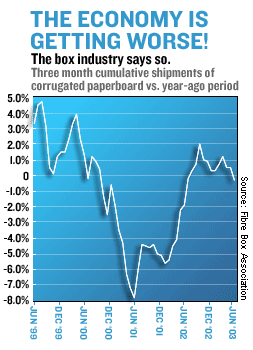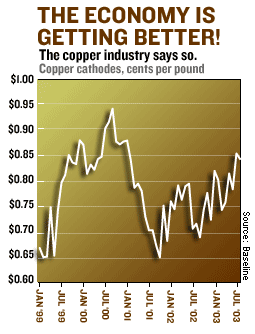NEW YORK (CNN/Money) - Think the economy is doing better? The people that make corrugated boxes respectfully disagree.
Yeah, boxes. You know, the containers that companies pack stuff into before they load them onto flatbeds or hand to the UPS guy or pack onto a freight car. Boxes, the things that the things you buy come in. You want to get an early lead on where U.S. business is going, why not take a look at the box business?

Well, it stinks. For five months in a row now, respondents to the Institute of Supply Management's survey on manufacturing have reported that corrugated cartons have fallen in price. Last week Smurfit-Stone Container said it would take "substantial downtime" due to weak demand. The Fibre Box Association reports that, through June, shipments of corrugated products were down a full percent from 2002.
Doesn't mean anything, you say? Then explain away the big drop in incoming cargo that the Port of Los Angeles -- the biggest port in these United States -- saw in June. Bet you can't do that, can you, Buster?
Actually, you probably can. (Helpful hint: Say it has something to do with SARS.) The beauty of this kind of economic "data" is that it isn't hard to shift it around to fit your view of where things are going. But that doesn't mean that people don't look in rather obscure places to try and get a leg up on where things are going -- particularly at times like this when the economy appears to be at some sort of turning point.
Those corrugated box shipments, for instance, began slipping in the first half of 2000, offering an early sign that the economy was beginning to cool off.

"Corrugated box shipments have also had some success in the past," said Citigroup economist Mitchell Held. "It could be an indicator that things aren't so great."
But Held points out that there's plenty of anecdotal data suggesting that things are improving -- and that good retail sales figures don't seem to jibe with the signal corrugated boxes are giving. To say nothing of copper prices (another offbeat indicator) which are rising and may be signaling increased demand.
Watching wacky economic data has a long history -- one that plenty of supposedly sober-minded economists have engaged in. Fed Chairman Arthur Burns, who had the top spot at the Fed from 1970 until 1978, watched freight car loadings. Alan Greenspan is known to watch heavy melt steel scrap prices which, the theory goes, move up as soon as manufacturing activity picks up.
Still, most economists stick to the more established economic data.
"Railcar shippings, Long Beach container traffic -- the problem with this stuff is that people come up with a story and then start cherry-picking data to support their view," said Raymond James economist Scott Brown.
The bigger problem with some of these quirky data, said Fine Financial Forecasting president Don Fine, is that they've lost their relevance. He used to follow scrap closely, for instance, but says now that it doesn't say much of anything -- first, because of the role of imports, but more importantly because goods producing has become so secondary in the services-oriented U.S. economy.
What Fine would really like now, is to be able to see stuff closely related to how the services business is doing, like commercial jet capacity. You see airplanes filling up, he says, and you know that the economy is getting better. The problem? There's no way to get that information until way too late.
Or hotel occupancy rates -- to get a good read on U.S. hotel occupancy rates would be sweet.
"Mid-February 1982 I was in Chicago staying at the Ritz Carlton," he said. "It was deathly quiet in that hotel -- somebody told me the occupancy rate was 11 percent. Back then, nobody knew that a recession had begun, but I did. I took one look around that hotel...good night."

|

